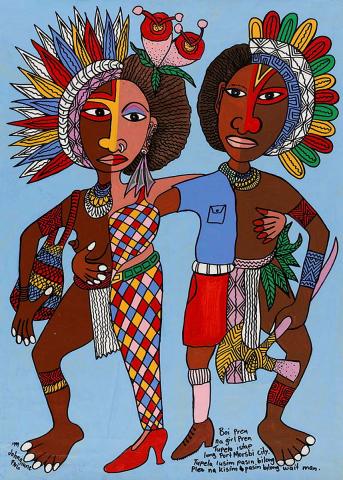John Siune: Boi pren na girl Pren Tupela I stap long Port Morsbi...
By Ruth McDougall
December 2016
Highlander artist John Siune is known for producing paintings full of irony that offer sophisticated commentary on contemporary Papua New Guinean life, society and politics. Taught by celebrated Chimbu artist Mathias Kauage, Siune’s paintings are worked in bold bright colour with textured embellishments drawn from patterning found on traditional wall matting, body decoration and weaponry. Often inspired by newspaper headlines of Papua New Guinea’s perceived social ills the works resonate with the acute honesty exercised by that country’s media.
A particular area of concern within the media as well as for the ‘naïve group’ of Highlander artists taught by Kauage, is the very quick transition in Papua New Guinea from village life to modernity. Concerns about new urban lifestyles, the influence of popular culture, and the change generated from participating in a cash economy are often played out on the figure of Papua New Guinean women with a whole genre of ‘Disco meri’ paintings depicting a female figure spit down the middle, one side representing a modern, urban way of life and style of dress and the other traditional bilas (ornamentation) worn in the village.
Writing about the Papua New Guinean transition to modernity, academic Paul Sharrad notes that ‘one of the common factors linking male and female … was a change in clothing’.1 Shorts, shoes and shirt or the female equivalent pants and top or ‘meri’ (women's) blouse became at once an outward sign of progress demonstrating access to the power of modern life. Yet, as Sharrad observes, in most literary and artistic texts 'the woman is identified with nation and tradition, and similarly satirised by male writers for departing from village habits and traditional dress'.2
In contrast, young men are pictured using the outward shows of modernity to enhance themselves in village society and perpetuate traditional relationships. Photographs abound of Papua New Guinea’s new leaders, dressed in suits, smoking cigarettes, leading modern lives that enhance the status of their wantok (people) while modern women are often pictured and inscribed as the site of a loss of local identity.
One of Siune’s contributions to the ‘Disco meri’ genre of paintings, Boi pren na girl Pren Tupela I stap long Port Morsbi city. Tupela lusim pasin bilong ples na kisim pasin bilong wait man (Boyfriend and girlfriend live in Port Moresby city. They leave traditional ways behind and take on whiteman style) 1999 is one of the few paintings that pictures both genders engaged in the transition to modernity. As the title suggests this transition is viewed as an attraction to the ways of the colonial white man and indeed, in the painting the skin of both figures whitens as they adopt their new attire and way of life. Interestingly the female figure retains her bilum, though now worn as a shoulder bag instead of traditionally, over the head and slung down the back.
John Siune’s painting documents the role that cloth and dress has played in the rapid social, cultural and political upheaval accompanying Papua New Guinea’s independence in 1975. The energy and vibrancy of his insightful social commentary are boldly narrated in media not derived from tradition. Yet there, is in the dressing up of these figures an element of customary sing sing and theatre. The painting like its subject carefully negotiates two worlds.
Endnotes
- Paul Sharrad, ‘Translations: Text and Textiles in Papua New Guinea’ in S Küchler and G Were, The Art of Clothing: A Pacific Experience, UCL Press, London, 2005, p.124.
- Sharrad, p.130.
